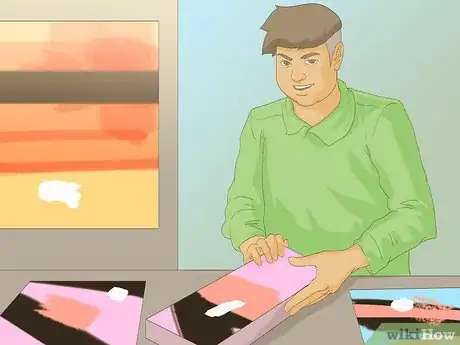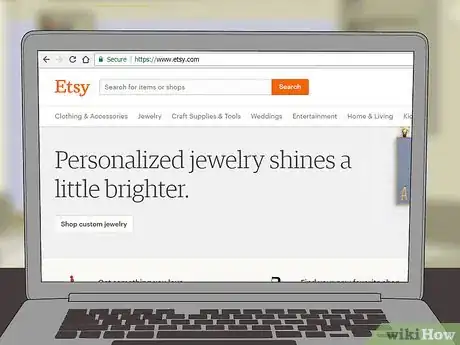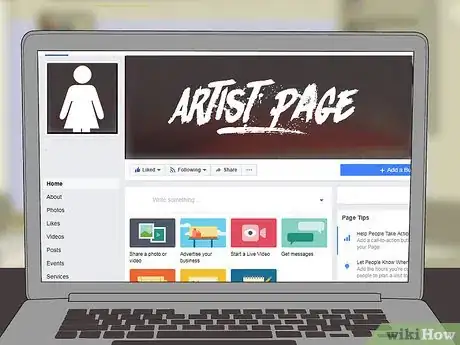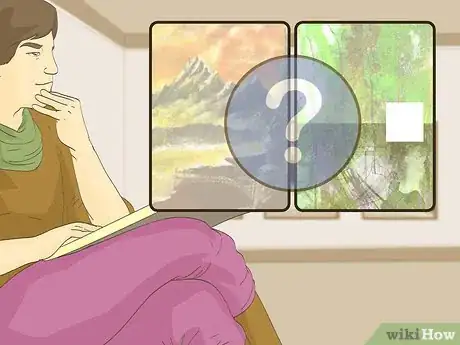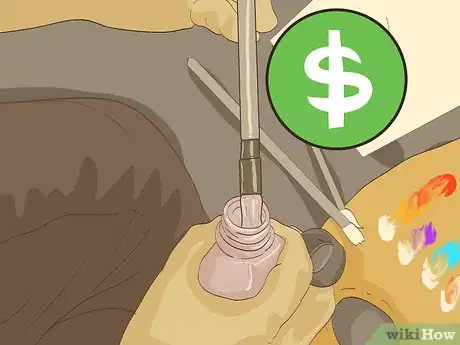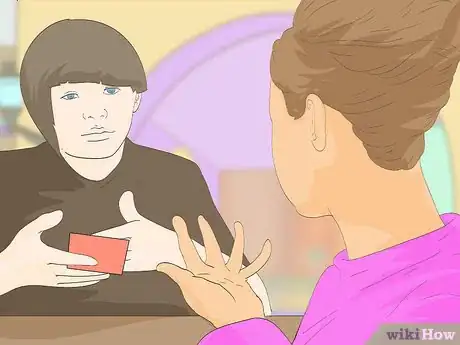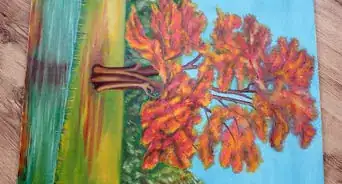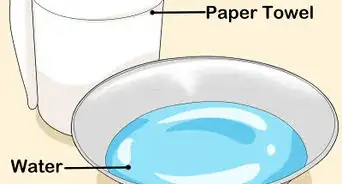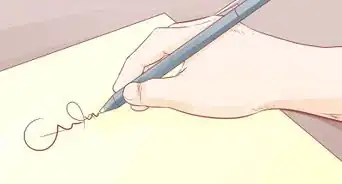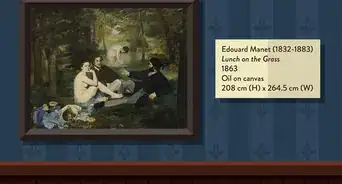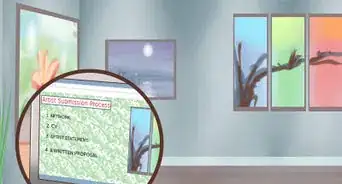This article was co-authored by Natasha Dikareva, MFA. Natasha Dikareva is a San Francisco, California based sculptor, and installation artist. With over 25 years of ceramics, sculpting, and installation experience, Natasha also teaches a ceramic sculpture workshop titled "Adventures in Clay" covering concept development, hand-building techniques, texture, and glazing techniques. Her work has been featured in solo and group exhibitions at the Beatrice Wood Center for the Arts, Abrams Claghorn Gallery, Bloomington Center for the Arts, Maria Kravetz Gallery, and the American Museum of Ceramic Art. She has taught at the University of Minnesota and the American Indian OIC School. She has been awarded the Excellence Award at the 1st World Teapot Competition, Best in Show at the 4th Clay & Glass Biennial Competition, and a Grand Prize at the American Museum of Ceramic Art. Natasha holds an MFA from the University of Minnesota and a BFA from Kiev Fine Arts College.
There are 18 references cited in this article, which can be found at the bottom of the page.
wikiHow marks an article as reader-approved once it receives enough positive feedback. In this case, 92% of readers who voted found the article helpful, earning it our reader-approved status.
This article has been viewed 273,800 times.
Who says art doesn’t pay? If you’re tired of the “starving artist” label, there are a few avenues you can follow to begin making a little money off the works you create—all it takes is commitment and knowing where to look for opportunities. By taking part in sales and exhibits, working out deals with local businesses and marketing yourself on social media, you’ll be one step closer to turning your passion into a living.
Steps
Putting Your Art on Display
-
1Submit your work to a gallery. If you have an art gallery in your area, contact the owner or submissions director and ask for information about how to get one or two of your pieces displayed there. For many artists, this is the best way to bring their art to the attention of collectors and enthusiasts who are willing to pay good money for original productions.[1]
- You might be required to submit a resume or portfolio, or there could even be an interview process to see if you’re the right fit for the gallery.
- Focus your attention on galleries where you believe your work would be a good fit.[2]
-
2Sell your pieces at a craft fair. Most cities regularly hold craft fairs and similar events where area creators are given a chance to sell their unique handmade goods. Keep your eye on the paper to find out when and where various events are taking place. Participating in one of these fairs will give you the chance to display your work, make sales and talk to interested parties one-on-one.[3]
- Operating your own booth will allow you to charge whatever price you think is fair for a given work.
Advertisement -
3Work with local businesses. In some cases, it may be possible to have your work put on display at restaurants, law and real estate offices and curio shops within your community. These businesses are always looking for interesting items to decorate their offices with, and are usually happy to collaborate with artists seeking exposure.[4]
- Put together a portfolio that includes some of your best work. That way, you’ll have something to show when making your case to the business’s owner.[5]
- In this type of arrangement, the business hosting the art will usually take a percentage of the proceeds.
-
4Advertise on the news. Get in touch with your local newspaper or television station and see if they’d be willing to interview you. It’s not uncommon for news networks to showcase the works of local artists and tradesmen as part of a segment on regional culture. Getting featured on the news is one of the best ways to offer a glimpse of your art to a large and diverse audience.[6]
- If the pieces you create are unusual or noteworthy in some way, you might even be able to convince them to do a whole story on you.
- Another option is to take out a print ad that will help raise awareness of your personal brand.[7]
Selling Your Art Online
-
1Set up an online store. Sites like Etsy, DeviantArt, Artsy and Imagekind provide a perfect platform for making your art accessible to potential collectors all over the world.[8] Just upload photos of your work, set prices for each item and use a separate program like PayPal to process payments. You can then handle all the financial transactions and shipping yourself.[9]
- Curate your content by theme so that it will more visible to people hunting for art of a specific type.
- E-commerce hubs like Big Cartel and Shopify might also be useful for selling your art online.[10]
-
2Promote your art through social media. If you haven’t already, sign up for a separate account for your art on Facebook, Instagram or Tumblr.[11] Many modern artists have found success using social media to build a dedicated following. More likes and shares means more exposure, which can, in turn, lead to more sales.[12]
- Include a link to your online store somewhere front and center in your bio to make it easier for users to purchase the pieces they’re browsing.
- Spending a little extra money on sponsored posts will ensure that it reaches more eyes.[13]
-
3Create a webpage. As part of your online presence, it’s a good idea to give interested parties a dedicated place to find out more about what you do. That way, potential buyers can read up on you, explore your finished works and get in touch with you directly. A standalone website will attract the interest of people who don't use social media to keep up with emerging artists.[14]
- Your website could be as sophisticated as an interactive portal that allows shoppers to preview slideshows of your work or as simple as a blog.
- Make sure your contact info is displayed somewhere in plain sight, along with a mission statement and brief explanation of your style.[15]
Building a Devoted Following
-
1Market to your likely audience. If you want to sell more art, it’s important to first have an understanding of who’s most inclined to buy it. Think about the dominant images or ideas contained in your work and what sort of views they reflect. Once you’ve identified your core fanbase, you can begin developing strategies that will allow you to bring your art to their attention more effectively.[16]
- Modern pop art full of cultural references, for instance, is more likely to appeal to other artists and art aficionados, whereas traditional watercolor landscapes will be more popular with a general audience.
- Advertise in places where your target demographic has the greatest chance of stumbling upon your work.
-
2Present your art yourself. Anytime you’re at an exhibition or event, stick close to your work so you’ll be available to answer questions and highlight interesting features. Being friendly and approachable will encourage people to take a closer look. In the best case, it may even give casual onlookers the push they need to add a piece to their personal collection.[17]
- Being able to describe your creative process is instrumental in helping people better connect to your art.[18]
- Be ready to explain the complex themes in your work and provide insight into your influences and favorite techniques.
-
3Do commissioned work. Commissions are the bread and butter of many professional artists. When a buyer hires you to produce a commission, it’s like signing a contract that guarantees you a paycheck. Approach each commission differently and work out a price you think is fair for the request.[19]
- The best way to entice people to buy commissions is to advertise the option for custom artwork on your business card, exhibition display or website.
- Commissioned work should take precedence over other pieces.
- It’s a good idea to ask for a percentage of the payment up front in case the buyer tries to back out later on.[20]
-
4Get your name out there.[21] All the exposure in the world won’t mean anything if no one knows who you are. Be sure to introduce yourself to everyone you meet, and remind them of your name before you part ways. You might even consider printing up some business cards that you can hand out at exhibitions and networking events.[22]
- Come up with a separate name for your studio or personal business, such as “The Rickety Easel” or “Ada’s Impressions.”
- Your business cards should include your first and last name, a brief overview of the type of art you create and a simple but eye-catching graphic that offers a glimpse of your signature style.[23]
Expert Q&A
-
QuestionHow do I make more money as an artist?
 Natasha Dikareva, MFANatasha Dikareva is a San Francisco, California based sculptor, and installation artist. With over 25 years of ceramics, sculpting, and installation experience, Natasha also teaches a ceramic sculpture workshop titled "Adventures in Clay" covering concept development, hand-building techniques, texture, and glazing techniques. Her work has been featured in solo and group exhibitions at the Beatrice Wood Center for the Arts, Abrams Claghorn Gallery, Bloomington Center for the Arts, Maria Kravetz Gallery, and the American Museum of Ceramic Art. She has taught at the University of Minnesota and the American Indian OIC School. She has been awarded the Excellence Award at the 1st World Teapot Competition, Best in Show at the 4th Clay & Glass Biennial Competition, and a Grand Prize at the American Museum of Ceramic Art. Natasha holds an MFA from the University of Minnesota and a BFA from Kiev Fine Arts College.
Natasha Dikareva, MFANatasha Dikareva is a San Francisco, California based sculptor, and installation artist. With over 25 years of ceramics, sculpting, and installation experience, Natasha also teaches a ceramic sculpture workshop titled "Adventures in Clay" covering concept development, hand-building techniques, texture, and glazing techniques. Her work has been featured in solo and group exhibitions at the Beatrice Wood Center for the Arts, Abrams Claghorn Gallery, Bloomington Center for the Arts, Maria Kravetz Gallery, and the American Museum of Ceramic Art. She has taught at the University of Minnesota and the American Indian OIC School. She has been awarded the Excellence Award at the 1st World Teapot Competition, Best in Show at the 4th Clay & Glass Biennial Competition, and a Grand Prize at the American Museum of Ceramic Art. Natasha holds an MFA from the University of Minnesota and a BFA from Kiev Fine Arts College.
Ceramics & Sculpting Instructor Try to make connections with people so they remember your name. Additionally, create business cards so you can hand them out to people at art events and to potential customers.
Try to make connections with people so they remember your name. Additionally, create business cards so you can hand them out to people at art events and to potential customers. -
QuestionHow do I get my artwork noticed?
 Natasha Dikareva, MFANatasha Dikareva is a San Francisco, California based sculptor, and installation artist. With over 25 years of ceramics, sculpting, and installation experience, Natasha also teaches a ceramic sculpture workshop titled "Adventures in Clay" covering concept development, hand-building techniques, texture, and glazing techniques. Her work has been featured in solo and group exhibitions at the Beatrice Wood Center for the Arts, Abrams Claghorn Gallery, Bloomington Center for the Arts, Maria Kravetz Gallery, and the American Museum of Ceramic Art. She has taught at the University of Minnesota and the American Indian OIC School. She has been awarded the Excellence Award at the 1st World Teapot Competition, Best in Show at the 4th Clay & Glass Biennial Competition, and a Grand Prize at the American Museum of Ceramic Art. Natasha holds an MFA from the University of Minnesota and a BFA from Kiev Fine Arts College.
Natasha Dikareva, MFANatasha Dikareva is a San Francisco, California based sculptor, and installation artist. With over 25 years of ceramics, sculpting, and installation experience, Natasha also teaches a ceramic sculpture workshop titled "Adventures in Clay" covering concept development, hand-building techniques, texture, and glazing techniques. Her work has been featured in solo and group exhibitions at the Beatrice Wood Center for the Arts, Abrams Claghorn Gallery, Bloomington Center for the Arts, Maria Kravetz Gallery, and the American Museum of Ceramic Art. She has taught at the University of Minnesota and the American Indian OIC School. She has been awarded the Excellence Award at the 1st World Teapot Competition, Best in Show at the 4th Clay & Glass Biennial Competition, and a Grand Prize at the American Museum of Ceramic Art. Natasha holds an MFA from the University of Minnesota and a BFA from Kiev Fine Arts College.
Ceramics & Sculpting Instructor Start by sharing your artwork on social media. Create accounts on all platforms so more people will see your art. Additionally, talk to people about your art and hand out business cards.
Start by sharing your artwork on social media. Create accounts on all platforms so more people will see your art. Additionally, talk to people about your art and hand out business cards. -
QuestionHow do I price my artwork to sell?
 Natasha Dikareva, MFANatasha Dikareva is a San Francisco, California based sculptor, and installation artist. With over 25 years of ceramics, sculpting, and installation experience, Natasha also teaches a ceramic sculpture workshop titled "Adventures in Clay" covering concept development, hand-building techniques, texture, and glazing techniques. Her work has been featured in solo and group exhibitions at the Beatrice Wood Center for the Arts, Abrams Claghorn Gallery, Bloomington Center for the Arts, Maria Kravetz Gallery, and the American Museum of Ceramic Art. She has taught at the University of Minnesota and the American Indian OIC School. She has been awarded the Excellence Award at the 1st World Teapot Competition, Best in Show at the 4th Clay & Glass Biennial Competition, and a Grand Prize at the American Museum of Ceramic Art. Natasha holds an MFA from the University of Minnesota and a BFA from Kiev Fine Arts College.
Natasha Dikareva, MFANatasha Dikareva is a San Francisco, California based sculptor, and installation artist. With over 25 years of ceramics, sculpting, and installation experience, Natasha also teaches a ceramic sculpture workshop titled "Adventures in Clay" covering concept development, hand-building techniques, texture, and glazing techniques. Her work has been featured in solo and group exhibitions at the Beatrice Wood Center for the Arts, Abrams Claghorn Gallery, Bloomington Center for the Arts, Maria Kravetz Gallery, and the American Museum of Ceramic Art. She has taught at the University of Minnesota and the American Indian OIC School. She has been awarded the Excellence Award at the 1st World Teapot Competition, Best in Show at the 4th Clay & Glass Biennial Competition, and a Grand Prize at the American Museum of Ceramic Art. Natasha holds an MFA from the University of Minnesota and a BFA from Kiev Fine Arts College.
Ceramics & Sculpting Instructor Look for a similar type of work and how much are people charging so you can establish a base price. In the beginning, go lower in price so you can sell, and then you can increase your prices as you sell more and more works.
Look for a similar type of work and how much are people charging so you can establish a base price. In the beginning, go lower in price so you can sell, and then you can increase your prices as you sell more and more works.
References
- ↑ http://www.artbusiness.com/artists-how-to-get-your-art-into-galleries.html
- ↑ http://faso.com/fineartviews/2159/12-steps-to-get-your-artwork-noticed-by-galleries
- ↑ http://www.agora-gallery.com/advice/blog/2014/11/18/how-to-sell-your-art/
- ↑ https://skinnyartist.com/5-ways-to-market-your-art-in-your-community/
- ↑ http://www.artbusiness.com/consultpurp.html
- ↑ https://skinnyartist.com/5-ways-to-market-your-art-in-your-community/
- ↑ https://clintavo.com/blog/112301/how-to-advertise-your-art-in-art-magazines
- ↑ Natasha Dikareva, MFA. Ceramics & Sculpting Instructor. Expert Interview. 5 May 2020.
- ↑ https://theabundantartist.com/15-ways-to-sell-your-art-online/
- ↑ https://www.inc.com/bill-carmody/top-5-ecommerce-platforms-for-2017.html
- ↑ Natasha Dikareva, MFA. Ceramics & Sculpting Instructor. Expert Interview. 5 May 2020.
- ↑ https://www.shopify.com/blog/211990409-how-to-sell-art-online
- ↑ https://blog.hootsuite.com/social-media-advertising/
- ↑ https://www.theartleague.org/blog/2013/03/21/how-to-create-an-artist-website/
- ↑ http://www.artbusiness.com/weberrors.html
- ↑ http://theworkingartist.com/how-to-sell-your-art
- ↑ Natasha Dikareva, MFA. Ceramics & Sculpting Instructor. Expert Interview. 5 May 2020.
- ↑ http://theworkingartist.com/how-to-sell-your-art
- ↑ http://www.huffingtonpost.com/clara-lieu/how-do-artists-handle-commissions_b_7971146.html
- ↑ http://www.artbusiness.com/privcom.html
- ↑ Natasha Dikareva, MFA. Ceramics & Sculpting Instructor. Expert Interview. 5 May 2020.
- ↑ http://www.agora-gallery.com/advice/blog/2014/11/18/how-to-sell-your-art/
- ↑ http://emptyeasel.com/2013/03/15/6-tips-for-creating-artist-business-cards-that-actually-help-sell-your-art/
About This Article
If you’re an artist who's ready to turn your passion into profit, work on getting your art out into the community where it can be seen. To get more people interested in your work, contact local galleries about putting your work on display. In some cases, you might also be able to display your work at restaurants, business offices, or shops in your community. You can also sell your pieces at craft fairs. Another way to sell your artwork is to set up an online store. Sites like Etsy, DeviantArt, and Artsy are perfect for making your art accessible to potential buyers all over the world. Just upload images of your work, set prices, and use a program like PayPal to process payments. You can also promote your artwork through social media by starting a new Facebook page, Instagram, or Tumblr just for your business. To learn how to build a devoted following for your artwork, keep reading!

